The belief that a strong core is the be-all-and-end-all cure for our back problems, including sciatica, is unfortunately a myth. Back pain and sciatica run far deeper than just core muscle weakness. We know from years of research that there are multiple other factors at play.
Nevertheless, strong core muscles – by this, I mean the abdominal, spinal, and hip muscles – are all imperative for supporting movement, maintaining mobility and preventing instability which can cause injury.
This article is designed to provide you with some of the best core exercises for sciatica to build core strength and improve stability around the spine.
My priority when choosing these exercises is that they are safe for the majority of people with sciatica. However, as everyone is different it is essential that any reader with sciatica obtains a thorough medical assessment before engaging with the exercises in this article (or any other online resource) as these exercises will not be suitable for all.
Core Strengthening to Relieve Sciatica
First: What is the “Core”?
The “core muscles” are a group of muscles that support the middle of the body. The core is made up of multiple muscles from the spinal, abdominal and hip region.
Some people wrongly think of the core as just the “six-pack” muscle at the front of the tummy. This is one small part of the core – but there are lots of others muscles involved too. Examples of some of the muscles that make up the core are: transversus abdominus, multifidus, the obliques and the erector spinae muscle group.
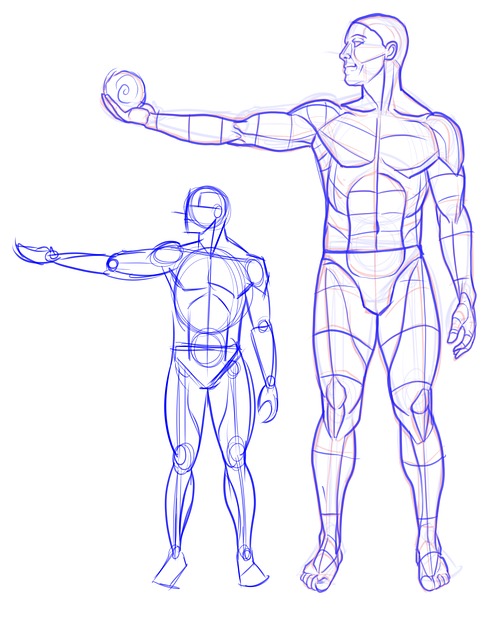
The core has a very important job. The role of the core is to stabilise the spine when we move, bend and twist, so we can perform all of these movements safely and efficiently.
It is the responsibility of the core to prevent injury to the spinal joints, discs and muscles. Without the core, you would not be able to walk, run or even sit. Your spine would also be very exposed to the risk of injury upon an attempt to do any of these movements. Therefore, having a strong core is vital for safe human movement.
Why is Core Strengthening Important for Sciatica?
The lumbar spine, which is area of spine which makes up the lower back, supplies the nerves to our legs. Injury to this area is common, given our lumbar area is one of our most frequently recruited sites for movement.
Your sciatic nerve is the largest in the body, running from your lower back and down through your legs. Compression or irritation of the sciatic nerve roots can cause the pain known as sciatica – typically a sharp, shooting pain that may prevent you from being able to perform much movement.

Strong core muscles take the pressure off your spine and can reduce the risk of many of the types of injury that cause sciatica. A strong core can do this by preventing “micro-motions” in the spinal spaces which would otherwise risk damaging the nerve roots.
A strong core can also prevent uncontrolled movements of the spine and lead to a reduction in the risk of an injury like a disc herniation.
If one already suffers from sciatica, strengthening the core can help the problem to get better faster by taking pressure off the spine. It can also reduce the risk of re-injury.
However, we should always remember that there is more to recovery from sciatica than just getting a stronger core. You can read why here.
How to Train the Core Safely
Let’s set out some ground rules for what to avoid when looking to strengthen the core for the purposes of treating sciatica and/or lower back pain.
Movement that flexes your spine, or hinges you forward, is likely to exacerbate your pain, as these movements can aggravate the sciatic nerve. Therefore, we want to avoid any exercise that puts you into a position of spinal flexion.

We want to avoid away from exercises that require us to hold both legs off the ground. Exercises such as double leg lifts, flutter kicks, double leg circles and lying toe touches do work your abdominal muscles, but during these exercises there can be strain placed on your lower back. Your lower back can be pulled upwards, compressing the space around your lumbar spine.
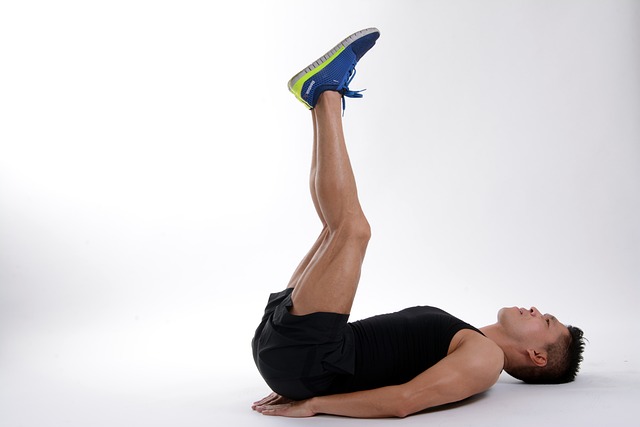
When both your legs drop towards the floor your lower back is forced into the floor, as it bears all the weight of keeping your legs above the ground. Your lower back becomes the anchor which stops you overbalancing.
For most people, even the fittest of athletes, they will have to fight hard to keep their back flat on the ground whilst performing these movements; again, showing how the spine is struggling to stay neutral, with all strain placed on the lower back and pelvis muscles.
Furthermore, when both legs are facing straight up to the ceiling, this puts a stretch on the sciatica nerve. Nerve pain usually gets WORSE when the sciatic nerve is stretched, even in a well-meaning exercise.
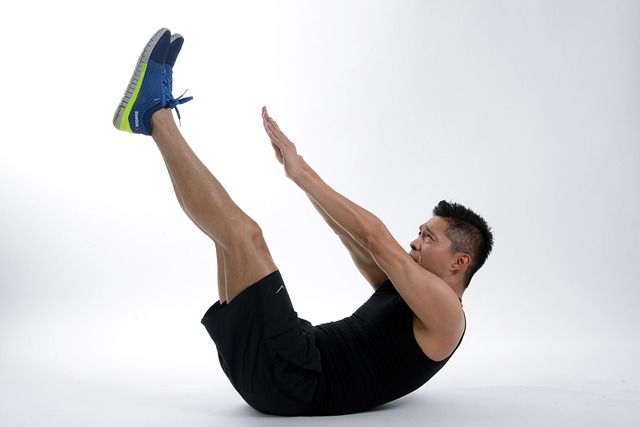
The above picture shows a position that stretches the sciatic nerve. When we jolt forward and reach for our toes, we are actually putting a STRETCH on the spinal cord, which in turn STRETCHES the sciatic nerve. This makes the problem worse.
You can get a better explanation of this in the video below:
A lot of these crunching actions demonstrated above force the lumbar spine into flexion. There is a slight natural curve in our lumbar spine. When we perform movements that go against this curve repeatedly, we are compressing our intervertebral discs, putting us at risk of bulging or herniating a disc.
See the below image to see how flexion, which occurs when we bend the lower spine forward, can cause a bulging disc.
A disc bulge is when one or more of the discs bulges outwards from its usual place in between two vertebrae. When the disc protrudes outwards, it can press against the spinal nerve roots, causing sciatica. Poor posture can apply unevenly weighted strain to the discs, resulting in disc bulges or herniation.
Before going forward, remember: Any core exercise for sciatica that causes you pain in the back or leg, no matter who recommended it, is NOT a good core exercise for you. If a movement is causing you pain, stop immediately.
You may be able to “feel” the exercise working, but it should not be painful in the back or leg.
This article explores in more detail some of the main exercises I recommend avoiding with sciatica.
Now, let’s talk about some of the best core exercises for sciatica.
The following exercises are provided for informational purposes only and are not designed to be a ‘prescription’ of any kind. Be sure to check with your healthcare provider before you begin any new exercise programme.
The Best Core Exercises for Sciatica (in no particular order)
#1 Walking on the spot
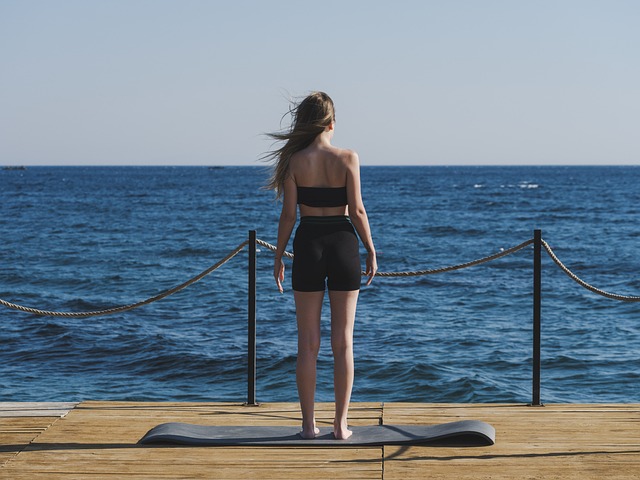
Now this one might sound simple, but don’t be too quick to judge! When you are suffering from sciatica, any movement may be difficult. It is important to start off with the basics and work your way up.
The way to make this simple exercise greatly benefit your core is by making it a very deliberate and controlled action.
Slowly lift your right leg up, bending at the knee, until your thigh is at a 90-degree angle to your pelvis – this may be too high for your specific sciatica, so only go as far up as you can go without experiencing pain. Then, slowly lower your leg and repeat with the left leg.
Whilst performing this movement, focus on maintaining your balance by keeping your core tight and controlling your breathing. It’s important to continue to move the hip and leg muscles when you’re suffering from sciatica, to prevent atrophy (muscle weakening) and tightening of your muscles which can worsen your pain.
If you are experiencing muscular weakness around your hips and pelvis or a bulging/herniated disc, this can have a domino effect on your movement which can cause degenerative changes if left untreated over a long period of time. If you’re loading more weight onto one area of your body when walking, to compensate for a postural imbalance, you’re likely to cause excess stress on that strained area.
Walking on the spot, using very controlled movement, can help to re-centralise your balance and improve muscle tightness and weakness.
#2 Plank
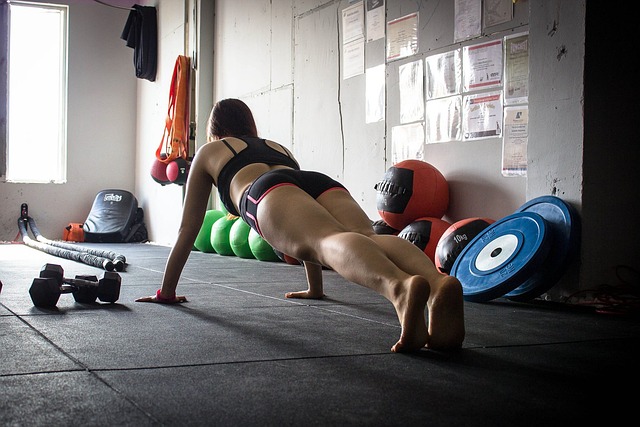
The plank is one of the most well-known core exercises, for good reason. The benefit to exercises like the plank is that they keep your spine in the properly aligned position.
A correctly performed plank requires you to hold the lumbar spine in a neutral position. This is important as it prevents overextension or flexion of the spine, and prevents placing disproportionate pressure on certain areas of the spine.
Simply put, when we perform movement outside of our neutral spinal range, we apply load to areas which aren’t accustomed to supporting weight and/or movement. This can aggravate bulging or herniated discs.
Additionally, as the plank is a static exercise (meaning we aim to not move whilst performing it) it doesn’t jolt the spine.
To make this exercise harder, support yourself using your forearms, rather than just your hands in a push-up position, as this will offer extra stability.
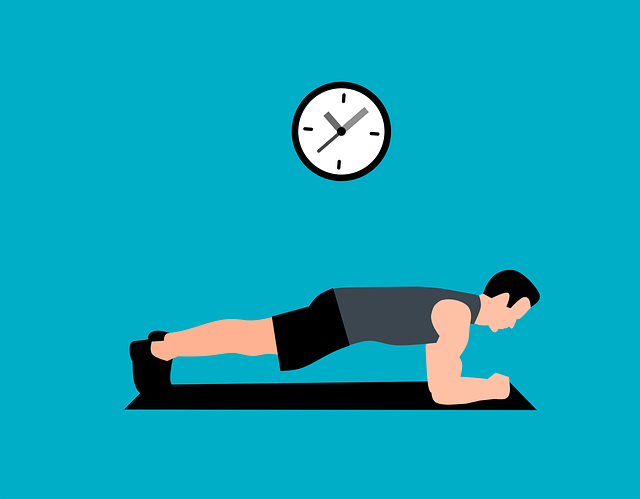
Planking is a great exercise for mindfully adjusting your posture, this helps increase awareness of how you’re stabilising yourself when going about your daily activities to ensure you’re evenly distributing weight.
Before performing planks, you should figure out whether you experience a pelvic tilt which you will have to account for to create a neutral line when planking. If you have a posterior pelvic tilt, your pelvis tilts forward.
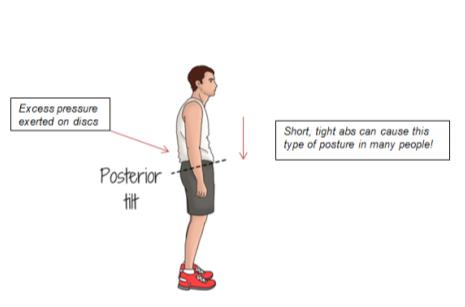
When planking, your pelvis may want to sag downwards, or your back may arch. Correct this by tilting your pelvis up slightly towards the ceiling.
If you have an anterior pelvic tilt, your pelvis will tilt backwards, exacerbating the curve in your lumbar spine. When planking, tuck your bottom in slightly to correct lumbar extension– your tailbone should not be pointing towards the ceiling. You want as straight a line as possible all the way from your neck down to your heels.
A tilt in either direction can be a contributing factor to the development of sciatica. Anterior pelvic tilt is often associated with tight hip flexors (like your piriformis muscle, which we will mention more later!). Check out the video below which can be useful in correcting an anterior pelvic tilt:
When the muscles around your hips are tight, they can irritate your sciatic nerve.
TOP TECHNIQUE TIP: set up a camera or mirror to review how your plank looks, so you can adjust your posture for the best effectiveness.
#3 Bird-Dog
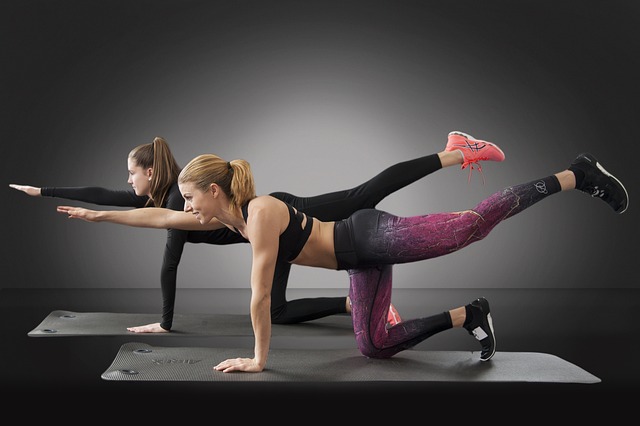
The bird-dog exercise may sound off putting, but it’s a fantastic exercise for engaging your core, whilst keeping your back safe.
Instructions:
- Lower yourself safely to the floor, onto your hands and knees
- Elevate one arm so that it is pointing straight out, in line with your shoulder
- Keeping your arm elevated, extend at the knee on the opposite side
- The whole body, including the arm and the leg, should be in alignment
- Now, bring both your arm and leg back up to the starting position
- Then do the same with the opposite arm and the other leg – whichever leg you are lifting, lift the opposite arm
The Bird-Dog exercise targets your transversus abdominis, which is the deepest abdominal muscle. The muscle runs horizontally; some people like to picture it as a corset for your spine.
This muscle is implicated in preventing back pain, as it is one of the most important muscles in the stabilisation of the spine and pelvis. Keeping your spine in place prevents compression or irritation of the nerve roots which can cause sciatica.
#4 Glute bridge
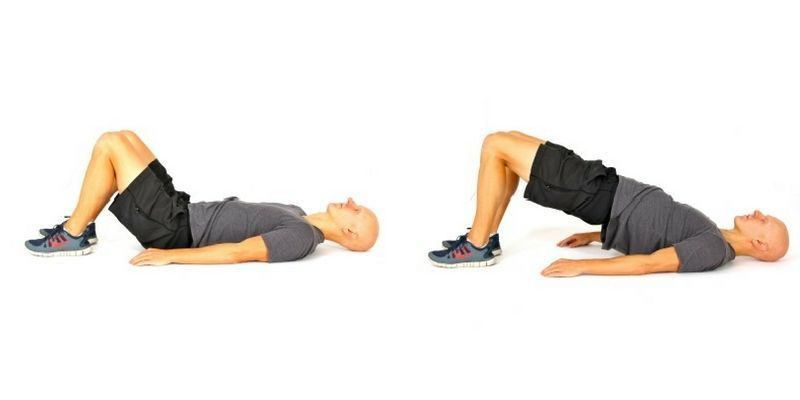
A glute bridge is a great exercise if you are suffering piriformis syndrome, which is a condition which may frequently cause sciatica.
The piriformis muscle is located in the buttocks; we have two piriformis muscles, one on each side, which run from the bottom of the spine to the top of the thigh.
The piriformis is an important muscle for the movement of your hips and your pelvis. If you are ever experiencing buttock pain which is isolated specifically to your gluteus it may be caused by your Piriformis.
The sciatic nerve passes very closely underneath the piriformis muscle, as it travels through the buttock region.

The left piriformis muscle is shown in red, with the yellow drawing depicting where the sciatic nerve runs.
Damage to the piriformis muscle can cause inflammation and/or muscle spasms, all of which can alter the shape of the muscle. These changes to the muscle can force it to press against the sciatic nerve. This can lead to the symptoms of sciatica.
We can this condition piriformis syndrome.
Some people think of sciatica and piriformis syndrome as the same thing; technically, sciatica describes the SYMPTOM, while piriformis syndrome can be the CAUSE of the symptom.
I’ve heard many testimonies to the wonders of a glute bridge for helping piriformis syndrome pain. Importantly, effectively activating and strengthening the piriformis muscle and the surrounding gluteal muscles prevents inflammation and muscle spasms which can cause sciatica.
Our body is a complex organisation of interconnected systems; when there is weakness in one area, this often has a knock-on effect on the surrounding areas.
In the way strong spinal muscles help stabilise the spine, strong glute muscles support hip stability and movement. Weak glute muscles can cause your legs to rotate inwards (adduct), throwing off their ability to effectively support you during activity and weight-bearing tasks. This can cause overextension and/or put extra strain on your piriformis.
Weakness in any muscle around your hips can offset your balance when walking or running, straining your surrounding muscles as they attempt to compensate. Remember, all of this can cause pain in and of itself, but inappropriate movement of your spinal or hip structures can also impact the sciatic nerve.
Aside from the glutes, glute bridges are an effective exercise for strengthening your core muscles. Importantly, glute bridges help strengthen your transversus abdominis and multifidus, which are muscles which encase your midsection.
The multifidus travels down your entire spine and is most prominent within the lumbar area. Studies have found that core stabilisation exercises can increase the size and strength of the multifidus, which was related to decrease in chronic lower back pain1.
#5 McKenzie Side Bends
The McKenzie Side Bends get their name from physical therapist Robin McKenzie2; you may also see them called side glides. This is a highly effective pain relief exercise, as well as functioning to restore you range of motion when sciatica pain is present to protect your core mobility.
This exercise is most effective when your sciatica pain is present down one side of the body, meaning the damage (disc herniation, erosion of the spaces around the nerves, one swollen piriformis muscle etc.) is localised to one area or side of the body.
I have found this exercise often brings significant and rapid sciatica pain relief to many people.

Instructions:
- Start standing next to a wall. Most people prefer to do this exercise with their painful leg being the one FURTHEST AWAY from the wall. However, try both sides and see which one is most comfortable for you – stick with that one.
- Use your elbow and forearm to support yourself so you are leaning on the wall (1st picture)
- Slowly and gently, let your hips “glide” towards the wall while keeping your feet in the same position.
- Only go as far as is comfortable, then return to the start position.
- Repeat this 10 times, have a break, and do 3 sets total.
- If this exercise has worked for you, you may feel rapid relief in the painful leg and possibly slightly worsening back pain – rest assured this is a normal phenomenon.
The McKenzie approach claims to work by encouraging the inner disc material (called the “nucleus pulposus”) to re-centralise into the middle of the spinal disc.
Whether or not this actually occurs hasn’t been proven in scientific literature but I have seen this exercise provide relief for many. I tell my clients to be sure to choose the direction that is least painful when performing this exercise.
#6 Ball Draw-In
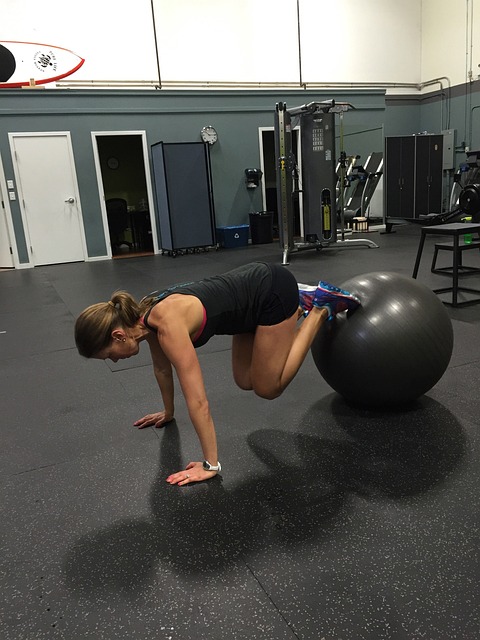
The ball draw-in is a great option for many people with sciatica because it avoids flexion or extension of the lumbar spine while still activating all of the important core muscles.
This exercise is more suited to those who already have some baseline level of fitness. If you cannot do a press up, this core exercise might be best avoided.
For this exercise, a gym ball is needed. The starting position is the same as the start of a press-up but with the legs resting on a gym ball. Keeping the arms extended, the legs are used to roll the gym ball towards the chest. Then, the ball is allowed to roll back out again to the start position. This can be repeated 10-15 times if possible.
It is important in this exercise that the pelvis does not roll underneath the body, or the spine will be pulled into flexion which may aggravate sciatica.
The additional benefit of this exercise for sciatica is that the aim is to keep your spine as straight as possible, in the same way a plank does.
Summary
Let’s reiterate – a strong core is not the be-all-and-end-all of sciatica prevention and relief. We should renounce the myth that excessive and repetitive core exercises will completely prevent sciatica – if only it were that simple!
When sciatica pain is present, it is important not to risk applying any more strain or unpredictable movement which could worsen the nerve compression or irritation, as this will prevent healing.
When sciatica pain is present, we want to try to keep moving as much as possible to prevent atrophy and tightening of the muscles. However, we should not be hurting ourselves in the name of activity. If there is pain present when performing any of these activities, please stop any exercise immediately. Be sure to get checked by a professional before beginning any exercise for the purposes of strengthening your core when you have sciatica.
The information provided on Overcome Sciatica is for informational purposes only and should not be used as a substitute for individualised medical advice. Full terms here.
References
- Rastegar MM, M., Haghighi, A. and Askari, R., 2016. Effect of core stabilization exercise on the reduction of low back pain and ultrasonic changes of multifidus in aged-women with chronic low back pain. Anesthesiology and Pain, 7(2), pp.62-74.
